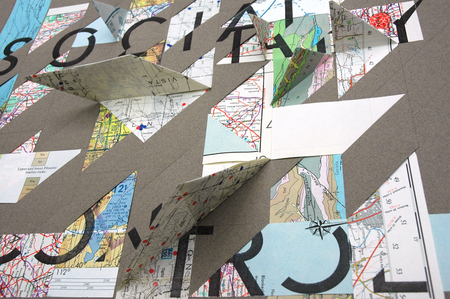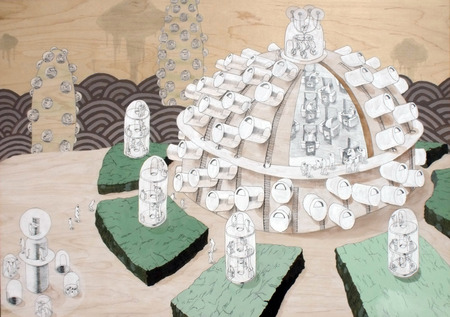Gallery Project exhibit offers fascinating, distinctive views of 'Imagined Communities'

"Social/Solitary" by Kelly Salchow
As is typical of Gallery Project, these images come in mind-boggling shapes and forms. Some artworks depict utopias, others dystopias. What they all have in common is a total lack of interest in social conformity.
The exhibit organizer, Oakland University Professor of Art Christopher Lee, expands on the exhibit’s purpose and meaning in his gallery statement. “Social media’s exponential growth has changed the nature and structure of human relationships,” says Lee, “from the creation of entirely new friendship groups, to fast spreading waves of political action.
“Traditional communities based upon geographic locality and a purpose-built physical space are being supplemented and in some cases, supplanted, by their web-based counterparts,” he concludes. “Just as the basic architecture of traditional communities is built upon and shifted organically based on the wants and needs of their participants, so too have social networks morphed beyond the foundations of their designers.”
These artists are confronting what many politicians seem unwilling to consider: alternative views of society, as well as careful examinations of what has not particularly fared well in contemporary societies. The exhibit is especially lively, with art that runs the range of social experience with all sorts of communities—real and imagined—vying for attention.
Local contributors include Ann Arbor’s Rocco DePietro, James Nollert, Janie Paul, Gloria Pritschet, Colin Raymond and Kelly Salchow. Also on hand are Brighton’s Melanie Manos and Ypsilanti’s Brian Spolans. Other artists range from Detroit to Lansing as well as the east and west coasts—and farther beyond to Europe.
For example, Helsinki, Finland’s Juan Kasari has contributed three Lambda prints on Alu-Dibond board with epoxy varnish titled “It Was Meant to be a Model for a Perfect Society” that are among the most stark dystopian images in the exhibit.
Kasari’s photographs featuring a dilapidated apartment complex at night are a social nightmare come true. Not dissimilar to “A Clockwork Orange’s” inner-city projects where a push was made to create affordable housing, Kasari’s images reflect the paucity of community that accompanied these ultimately benighted municipal developments.

"Arena" by Brian Spolans
Portland, Ore. photographer Sarah Gilbert’s archival digital C-Print “Absent Portraits I: Lights” is a concise view of community in absence. The photograph—featuring an unadorned wood wall with two light switches and three darkened rectangles where pictures once hung—is as haunting as it is marvelous. There’s a spare beauty to Gilbert’s image that makes “Absent Portraits I: Lights” akin to a minimalist composition while the precise digital reproduction emphasizes the wall’s handsome grain.
Ultimately, the artwork that best defines “Imagined Communities” is an installation in the Gallery Project’s basement. As is typical of the gallery, its basement is reason enough to visit repeatedly. And Gloria Pritschet’s “MySpace: The Prequel” fills this niche quite successfully.
Tucked in the far corner of the gallery’s lower level, “MySpace: The Prequel”—a slightly larger than body-sized silver capsule with a handle—sits in near darkness with a light shining behind. On entering, the capsule’s internal octagonal chamber turns out to be cast in highly reflective plastic with strips of miniature floor lighting bouncing reflections off the walls into what seems a recessed infinity. There’s a single stool in the center of the chamber and ambient music, “Glass Armonica,” by ex-Ann Arborite Zach Wallace, softly accompanies the installation.
The work’s cumulative effect is fascinating as Pritschet’s installation, with the viewer’s multiplied reflection cascading upon him or herself, creates an alternative sense of community—or, more accurately, an absence of community by celebrating the self’s many dimensions. Indeed, the chamber’s reinforced sense of seclusion lends the installation an eerie tranquility.
Conceptually brillian, “MySpace: The Prequel” harkens back to a time of personal privacy that is now almost seemingly lost. It’s going to take a lot of imaginative rebalancing of self and society to re-create it.
“Imagined Communities” will continue through Sept. 18 at Gallery Project, 215 S. Fourth Ave. Exhibit hours are noon to 9 p.m., Tuesday-Saturday; and noon to 4 p.m., Sunday. For information, call 734-997-7012.

